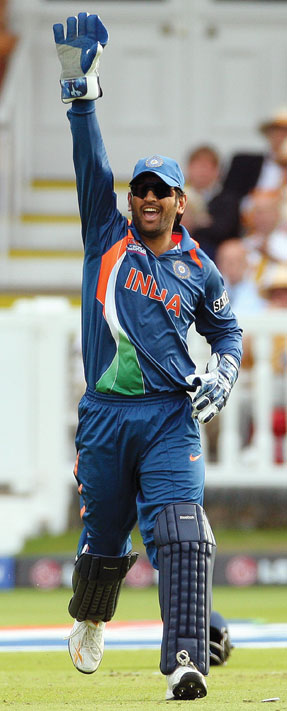Magazine
T20-DEBACLE After The Toast, The Roast

| “Hamara toh antim sanskar bhi ho gaya tha (our last rites too were completed) after the 2007 World Cup.” Captain Mahendra Singh Dhoni recalling the public ire after the Indian cricket team’s earlier humiliation in the 50-over version of the game. What was the Indian skipper, speaking at a media conference to refute team coach Gary Kirsten’s observation that player fatigue was responsible for India;s dismal performance at the recent T-20 World Cup in England, really hinting at? That adverse reactions from fans after a defeat have become routine in Indian cricket? And that, because they are routine, they are best ignored?
While the contribution of player fatigue to India’s pathetic and miserable title defence may be debatable, Dhoni and his teammates should thank their lucky stars for another kind of fatigue that has spared them the Indian public’s wrath: fan fatigue. If the team this time wasn’t deep-fried, as has been the case with some Indian teams in the past, the reason doubtlessly lies in the tedium of it all. How often can you be taken on a roller-coaster ride of ignominious defeats, followed by glorious victories, followed again by even more ignominious defeats, and still retain the fervor to respond with any modicum of passion? India’s failure to qualify even for the semi-finals of this year’s T-20 World Cup should have got the home fans riled up no end. Remember, our winning team was the toast of the previous (inaugural) edition of the Cup. It was hailed as the young new brigade led by Captain Cool who kept his nerve and emerged as an outstanding leader of talented but callow and potentially irascible lads, not to mention a youth icon for the advertising industry. And, as if to prove that the T-20 victory, coming as it did after India got pasted by lowly Bangladesh in the 2007 ODI World Cup in the West Indies, was no one-off fluke, Dhoni’s boys followed it up with consecutive series wins over the acknowledged supremo of modern-day international cricket — Australia — and the redoubtable Sri Lankans as well. So what cut the renaissance story short so abruptly and so cruelly? The Board of Control for Cricket in India got hot under the collar when Kirsten cited IPL-related fatigue for the team’s failure. Does it have anything to do with the fact that the BCCI took in a whopping $1.75-billion through the sale of Indian Premier League television rights, so blaming the IPL for a national defeat might dismay Indian fans? Kirsten has a valid point. Imagine playing a gruelling six-week tournament and beginning your defence of a world title just a few days later. Was there time enough to regroup, reorient, and redevelop strategies against the other teams, or even time enough to recover from the IPL razzle-dazzle and get match-fit? Obviously not. The argument that Indians were not the only ones who played the international league has validity. After all, nearly every other cricket-playing nation had representatives in the various IPL teams and several of them turned up for their national team in the T-20 World Cup as well — and significantly enough, gave some sterling on-field performances. But this argument fails to consider a very crucial difference. Indian cricketers, as a rule, are known for being less athletic to begin with, and then compounding this shortcoming with a lackadaisical and unprofessional approach to fitness training. The decade of the 1960s was abuzz with stories that the West Indian team believed in living it up during Test matches, which they rarely lost. The classic instance was of Gary Sobers guzzling an entire bottle of whisky through the night during the Bombay Test in December 1966, with a Bollywood starlet perched on his knee, and then playing superlative cricket the next morning to give India a thorough drubbing. By comparison, the Indian players who joined in the Sobers revelry looked — and played — like something the cat brought home. Virender Sehwag is a prime candidate. Clearly, there is more to his “injury” than meets the eye. Television clips indicate that Zaheer Khan, who took a fall much as Sehwag did, during the IPL season, appeared to have hurt himself more severely on his bowling shoulder than Sehwag who only bowls part-time. But Khan bowled his heart out in the T-20 matches, while Sehwag reportedly was unwilling even to play in the nets. Not only did the latter — the team’s vice-captain, no less — let his team down and ruin its chances, he also short-changed thousands of punters who had bet heavily on his run-tally being the tournament’s highest.
The T-20 loss signals the end of the honeymoon for Dhoni and his much-touted youthful team. The captain himself has gone through a rather strange learning curve at the cost of his innocence. He is no longer the simple, straight-forward and straight-talking small-town bloke from Ranchi. The first signs of the metamorphosis was evident from his refusal to attend the Padma Shri ceremony, an act that could dent his popularity and earnings as a product-endorser. What we have on our hands are a complacent bunch of filthy-rich superstars who believe that the team’s combined star-power will somehow win matches, and who are apt to think that the other guy will carry the team through. The latest debacle has exposed some old and new shortcomings in our cricketers. England exploited our old weakness against short-pitched deliveries, and South Africa exploded the myth that Indians are adept players of spin. In India’s last match in the T-20 tourney, South African spinners Johan Botha and Roelof van der Merwe bowled 8 overs for a combined 4 for 29. The joke among the wags is that the T-20 loss has made a few Indians happy. The multiplex owners can now count on bigger turnouts in their halls during cricket matches. And media magnates can now recall their correspondents from England ahead of schedule and thus save costs. But the real joke may be on us, the Indian cricket fans.
|


